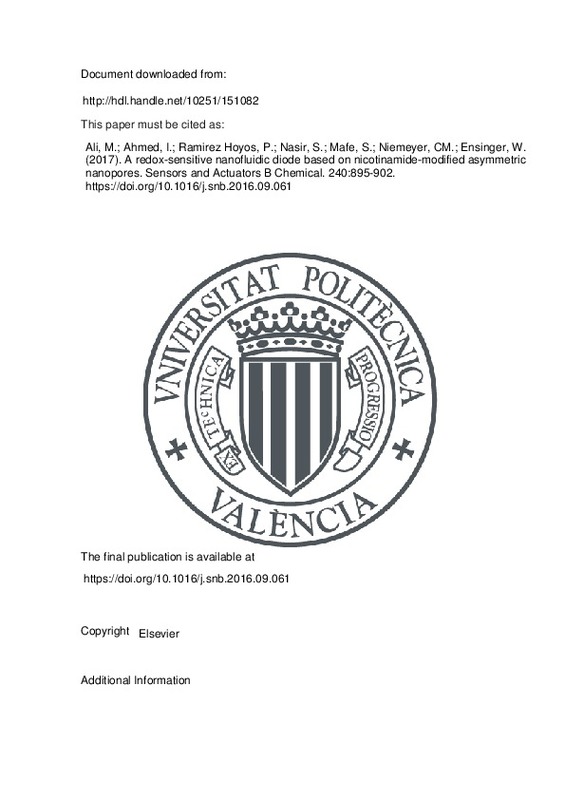JavaScript is disabled for your browser. Some features of this site may not work without it.
Buscar en RiuNet
Listar
Mi cuenta
Estadísticas
Ayuda RiuNet
Admin. UPV
A redox-sensitive nanofluidic diode based on nicotinamide-modified asymmetric nanopores
Mostrar el registro sencillo del ítem
Ficheros en el ítem
| dc.contributor.author | Ali, Mubarak
|
es_ES |
| dc.contributor.author | Ahmed, Ishtiaq
|
es_ES |
| dc.contributor.author | Ramirez Hoyos, Patricio
|
es_ES |
| dc.contributor.author | Nasir, Saima
|
es_ES |
| dc.contributor.author | Mafe, Salvador
|
es_ES |
| dc.contributor.author | Niemeyer, Christof M.
|
es_ES |
| dc.contributor.author | Ensinger, Wolfgang
|
es_ES |
| dc.date.accessioned | 2020-10-05T06:47:08Z | |
| dc.date.available | 2020-10-05T06:47:08Z | |
| dc.date.issued | 2017-03 | es_ES |
| dc.identifier.issn | 0925-4005 | es_ES |
| dc.identifier.uri | http://hdl.handle.net/10251/151082 | |
| dc.description.abstract | [EN] We demonstrate a redox-sensitive nanofluidic diode whose ion rectification is modulated by the oxidation and reduction of chemical moieties incorporated on its surface. To achieve this goal, we have first synthesized the chemical compounds 1-(4-aminobutyl)-3-carbamoylpyridin-1-ium (Nic-BuNH2) and 3-carbamoyl-1-(2,4-dinitrophenyl)pyridinium (Nic-DNP). Then, the surface of track-etched single asymmetric nanopores is decorated with the redox-sensitive Nic-BuNH2 and Nic-DNP molecules using carbodiimide coupling chemistry and Zincke reaction, respectively. The success of the modification reactions is monitored through the changes in the current¿voltage (I¿V) curves prior to and after pore functionalization. Upon exposing the modified pore to solutions of hydrogen peroxide (oxidizing agent) and sodium dithionite (reducing agent) the surface charge is reversibly modulated from positive to neutral, leading to measurable changes in the electronic readout of ion current passing through the nanopore. On oxidation, the quaternary nicotinamide units impart positive charge to the pore surface, resulting in the ion current rectification (anion-selective pore). On the contrary, the complementary reduced dihydronicotinamide moieties resulted in the loss of surface charge and ohmic behaviour (non-selective pore). The experimental results are further theoretically described by using Poisson-Nernst-Planck | es_ES |
| dc.description.sponsorship | M.A., S.N. and W.E. acknowledge the funding from the Hessen State Ministry of Higher Education, Research and the Arts, Germany, under the LOEWE project iNAPO. P. R. and S. M. acknowledge financial support by the Generalitat Valenciana (Program of Excellence Prometeo/GV/0069), the Spanish Ministry of Economic Affairs and Competitiveness (MAT2015-65011-P), and FEDER. I.A. and C.M.N. acknowledge financial support through the Helmholtz programme BioInterfaces in Technology and Medicine. The authors are also thankful to Prof. C. Trautmann, Department of Materials Research from GSI, for support with irradiation experiments. | es_ES |
| dc.language | Inglés | es_ES |
| dc.publisher | Elsevier | es_ES |
| dc.relation.ispartof | Sensors and Actuators B Chemical | es_ES |
| dc.rights | Reserva de todos los derechos | es_ES |
| dc.subject | Synthetic nanopores | es_ES |
| dc.subject | Redox reaction | es_ES |
| dc.subject | Nicotinamide | es_ES |
| dc.subject | Current rectification | es_ES |
| dc.subject | Surface functionalization | es_ES |
| dc.subject | Track-etching | es_ES |
| dc.subject.classification | FISICA APLICADA | es_ES |
| dc.title | A redox-sensitive nanofluidic diode based on nicotinamide-modified asymmetric nanopores | es_ES |
| dc.type | Artículo | es_ES |
| dc.identifier.doi | 10.1016/j.snb.2016.09.061 | es_ES |
| dc.relation.projectID | info:eu-repo/grantAgreement/MINECO//MAT2015-65011-P/ES/NANOFLUIDICA DE POROS BIOMIMETICOS: NUEVAS APLICACIONES EN CONVERSION DE ENERGIA Y SENSORES%2FACTUADORES/ | es_ES |
| dc.relation.projectID | info:eu-repo/grantAgreement/GVA//PROMETEO%2FGV%2F0069 | es_ES |
| dc.rights.accessRights | Abierto | es_ES |
| dc.contributor.affiliation | Universitat Politècnica de València. Departamento de Física Aplicada - Departament de Física Aplicada | es_ES |
| dc.description.bibliographicCitation | Ali, M.; Ahmed, I.; Ramirez Hoyos, P.; Nasir, S.; Mafe, S.; Niemeyer, CM.; Ensinger, W. (2017). A redox-sensitive nanofluidic diode based on nicotinamide-modified asymmetric nanopores. Sensors and Actuators B Chemical. 240:895-902. https://doi.org/10.1016/j.snb.2016.09.061 | es_ES |
| dc.description.accrualMethod | S | es_ES |
| dc.relation.publisherversion | https://doi.org/10.1016/j.snb.2016.09.061 | es_ES |
| dc.description.upvformatpinicio | 895 | es_ES |
| dc.description.upvformatpfin | 902 | es_ES |
| dc.type.version | info:eu-repo/semantics/publishedVersion | es_ES |
| dc.description.volume | 240 | es_ES |
| dc.relation.pasarela | S\317212 | es_ES |
| dc.contributor.funder | Generalitat Valenciana | es_ES |
| dc.contributor.funder | Ministerio de Economía, Industria y Competitividad | es_ES |







![[Cerrado]](/themes/UPV/images/candado.png)

